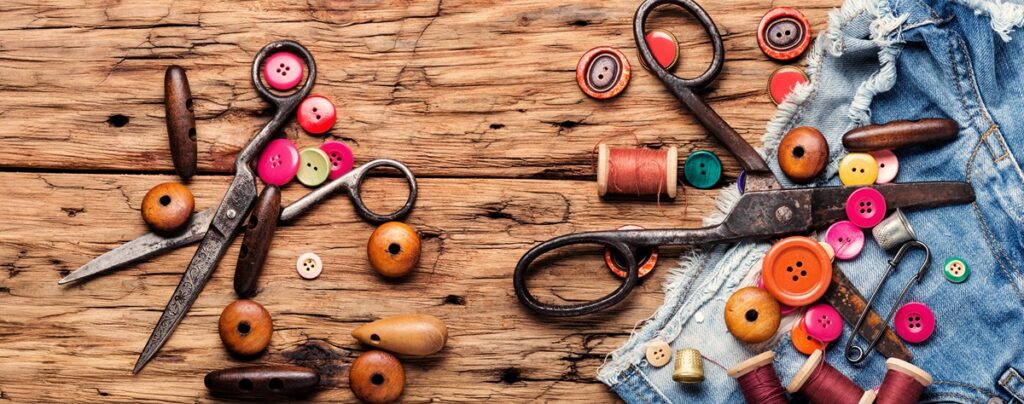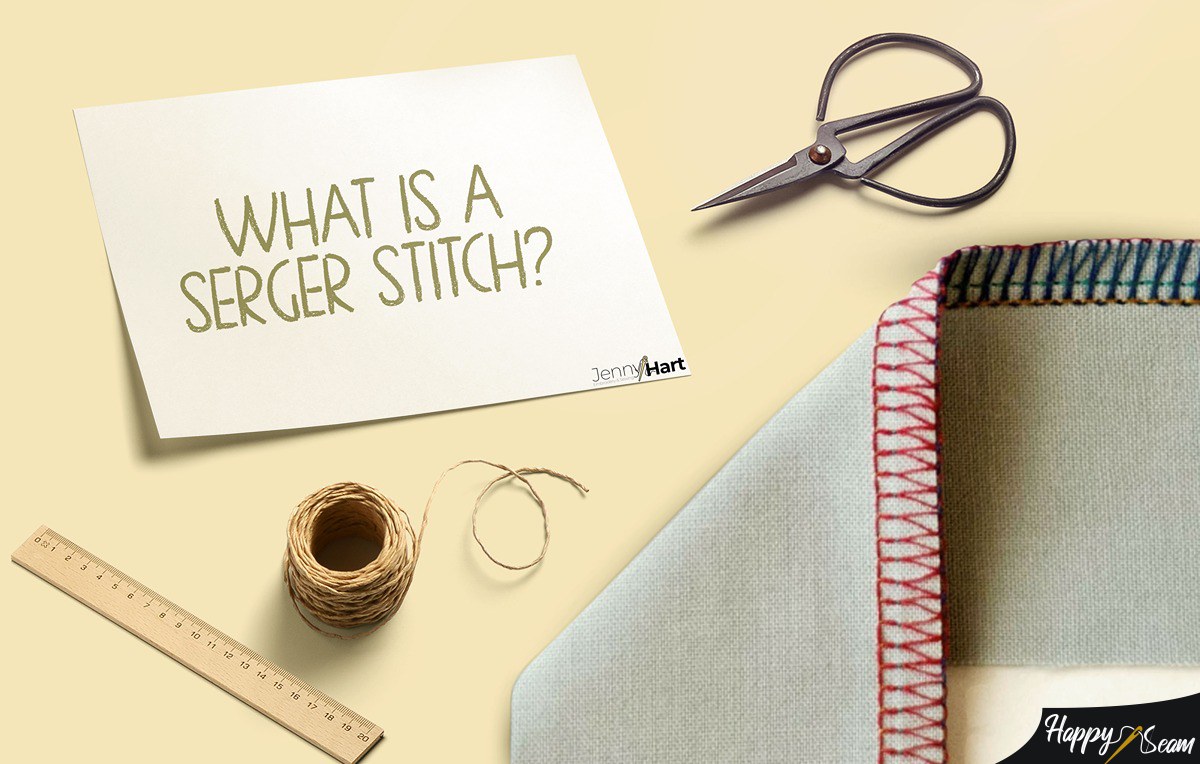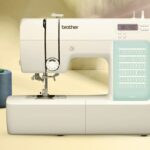If you’ve clicked on this article, that’s probably because you’ve recently heard about the serger stitch, and that it takes sewing to a whole new level. Or perhaps you’re already familiar with it and the variations it comes in, but you’re still unsure about which one to use, and when to use it.
So, now you want to know what exactly a serger stitch is and when you should use it. Well, you’re in the right place because that’s exactly what I’ll talk about in this article. So, let’s see.
Key Takeaways
- A serger stitch is a special type of stitch used for seaming and giving fabrics a nice, professional finish.
- There are various serger stitch types, each with its own features and uses, but the basic and most popular one is the overlock stitch.
- The 4-thread overlock stitch is the best for seaming thick and heavy-weight fabrics.
- What type of serger stitch you should use depends on the sewing project you’re working on, the fabric type, and the seam you need to create.
What Characterizes A Serger Stitch?

A serger stitch is ideal for sewing seams on fabrics and giving their edges a fine, neat, or even decorative finish. Moreover, it performs another function, which is preventing fabrics from getting worn along the edges.
Besides being used for simplifying and neatening edges, this type of stitch comes in quite handy for other sewing projects, such as inserting zippers, threading beads, and sewing elastic onto fabrics.
The serger stitch is typically done by a serger, which is a machine designed for the purpose of doing this type of stitch. It’s noteworthy that not all serger machines provide the same types of stitches. However, they allow you to adjust the tension and number of the threads, including the width of the stitches, as a result of which you end up getting various serger stitches.
Now, that I’ve mentioned that there are different serger stitches, let’s see what the most popular types are.
Also Read: Finest Coverstitch Machines
6 Most Commonly Used Serger Stitch Types
Two-Thread Overlock Stitch
This type of stitch has limited use as it is mostly used for making decorative and stretchy seams. It’s also great for giving the edges of lightweight and thin fabrics a fine, professional finish. However, it should be avoided for sewing seams on thick and heavy-weight fabrics as it’s not as secure and strong as the other overlock stitch types.
Three-Thread Overlock Stitch
This stitch is typically used for seaming lightweight, sheer fabrics, as well as medium-weight, knit, and woven fabrics. It’s especially used for seaming woven fabrics as it doesn’t let them fray.
The 3-thread overlock stitch has other applications too. For instance, it’s commonly used for creating decorative endings, trimming fabrics with lace and beads, and quilting as well.
Four-Thread Overlock Stitch
This is the widest and sturdiest overlock stitch type. Unlike the other two overlock stitches, this one is created by using 2 needles and 2 looper threads and it’s appropriate for sewing seams on thick knitted or woven garments, including clothing items that are often used.
If you’re someone who likes working on different sewing projects and you sometimes need to sew a strong and flexible seam that will last for longer, this is the type of stitch you should go with.
Two-Thread Flatlock
This type of stitch is used for sewing flat, aesthetically pleasing, or decorative seams that are not very bulky mostly on leisurewear and sportswear.
If you take a clothing item whose seams are sewn with the 2-thread flatlock stitch and you turn it inside out, you’ll easily notice the ladder shape of the seam on the inside, which is why this stitch is also known as a ladder stitch.
The only weakness of the 2-thread flatlock stitch is that it isn’t very sturdy, which is why it shouldn’t be used for attaching pieces of fabric together.
Mock Flatlock Stitch
This type of stitch is used for creating a flat, narrow seam that is comfortable and can be hardly noticed on the face of the fabric. So, it’s no wonder that it’s commonly used for sewing seams on knitted fabrics, activewear, and T-shirts.
Rolled Hem
This type of stitch is perfect for hemming fine and lightweight fabrics, including fabrics that tend to fray or unravel, as it gives their edges a clean, decorative, and attractive finish.
The rolled hem stitch is commonly seen on lightweight fabrics, such as lace, linen, silk, and organza, and lightweight clothing items, like underwear, scarves, silk nightwear, and lace or chiffon dresses.
This type of stitch isn’t difficult to sew, but it can take longer to do so.
Also Read: Can Sewing Thread Go Bad?
How To Tell Which Type Of Serger Stitch You Should Use

Since there are various serger stitch types, it’s crucial to choose the right type when working on a particular sewing project so that you can satisfy all your sewing needs and be content with the final results.
Now, in order to select a serger stitch type that will be the most appropriate for the project you intend to perform, you should consider certain aspects before making the choice. Those aspects include:
- What kind of sewing project you’ll be working on; (for example, whether you’ll be hemming or sewing seams on clothes, sewing sleep masks, zippers, or pillowcases, creating decorative stitching lines, quilting, or crafting, etc.)
- What type of fabric you’ll be working on; For instance, check if your fabric is lightweight, sheer, knitted, thick, medium- or heavy-weight.
- What type of seam your sewing project requires; For instance, think about whether you need a flat, comfortable, narrow, wide, stretchy, bulky, or solid seam.
Let me give you an example: If you’re stitching seams on a silk or lace dress, you’ll need to go with the rolled hem stitch as it’s great for creating narrow seams that don’t stick out and it gives the edges of lightweight fabrics attractive and neat finish. But if you’re sewing seams on a thick, heavy-weight woven fabric, in this case, you’ll need to go with the 4-thread overlock stitch since it’s wide, solid, and great for creating sturdy seams that can attach and keep two or more pieces of heavy-weight fabrics together for longer.
What Sewing Projects An Overlock Stitch Should Be Used For
This type of serger stitch is perfect for giving the edges of fabrics a professional, clean, and fine finish irrespective of whether you use the 2-thread, 3-thread, or 4-thread overlock stitch.
However, keep in mind that not all of them are appropriate for seaming all types of fabrics. For example, if you need to sew decorative and stretchy seams on thin or lightweight fabrics, you’ll want to use the 2-thread overlock stitch. Then, if you need to sew seams on medium-weight fabrics, no matter if they’re woven or knitted, you’ll want to use the 3-thread overlock stitch.
And finally, you’ll want to use the 4-thread overlock stitch when you need to sew seams on heavy-weight and thick fabrics or even create an entire garment.
Another instance when you can use an overlock stitch is whenever you make a garment and notice that you need to iron the seams to decrease their size. Well, using an overlock stitch to give the edges of that clothing item a good, smooth finish before you even begin with the construction rather than ironing the seams after you create it is a way better option.
Also Read: The Differences between a Coverstitch and Serger
Final Words
Since there’s a variety of serger stitches, it’s essential to choose the type that will help you get the best results no matter what sewing project you’re performing. So, I hope that this article will help you understand what a serger stitch is and when it should be used, and that it will make sewing easier and more fun for you.
I graduated from London College of Fashion, and I’ve been working for a Fashion Design company for 10 years. My other hobbies are going to the gym and reading.



